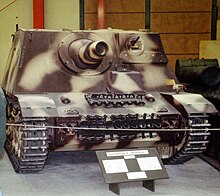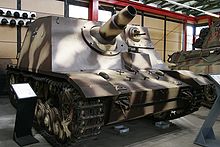Assault Tank IV
| Assault Tank IV | |
|---|---|

Sturmpanzer IV in the Musée des Blindés in Saumur |
|
| General properties | |
| crew | 5 men |
| length | 5.93 m |
| width | 2.88 m (with Ostkette 3.19 m) |
| height | 2.52 m |
| Dimensions | 28.2 t |
| Armor and armament | |
| Armor | front: 100 mm (at 40 ° inclination) side: 50 mm (at 18 ° inclination) rear: 30 mm (at 26 ° inclination) top: 20 mm (at 84 ° inclination) |
| Main armament | 15 cm stool 43 L / 12 |
| Secondary armament | 7.92mm MG 34 |
| agility | |
| drive |
Maybach HL 120TRM - 12 cylinders, 11.9 l displacement , 300 PS 300 PS (220 kW) |
| suspension | Leaf suspension |
| Top speed | 40 km / h (road) 24 km / h (terrain) |
| Power / weight | 10.64 hp / t |
| Range | 210 km |
The Sturmpanzer IV (Sd.Kfz. 166) was a heavy assault gun that was used by the German Wehrmacht in World War II .
Conception
Since the assault guns were used more and more often for tank hunting, the infantry lacked a support vehicle. In addition, it turned out during the fighting for Stalingrad that the previous assault guns did not have enough firepower in house-to-house combat. The available vehicles were gap fillers like the StuIG 33 B on Sturmgeschütz III chassis or like the Sturmpanzer I on converted chassis of outdated tanks, both equipped with a 15 cm sIG 33 howitzer. The Sturmgeschütz III, on the other hand, was unable to bring down an average city building with two to three shots, as was now required.
On June 9, 1941, a 15 cm SIG 33 should be mounted on a heavily armored chassis. It was therefore decided to construct a large-caliber assault tank on the chassis of the Panzerkampfwagen IV . The result was the Sturmpanzer IV, called "Grummbär" by the Allied forces; the German troops abbreviated this name with "StuPa". He received the 15 cm caliber howitzer 43 derived from the sIG 33 and was therefore ideally suited for the task of infantry support. The Altmärkische Kettenwerke presented the design to Adolf Hitler on October 6th or 14th, 1942. The design was strongly based on the very successful StuG III. Hitler approved the design and on February 7, 1943, the first original-size wooden models were presented to him. Convinced of the troops' need for these vehicles, he ordered an investigation into whether and how destroyed and damaged Panzerkampfwagen IV could be converted.
Production has been approved. A first series of 40 vehicles should be completed by May 12th, and another 20 vehicles should follow. Up to April 1943 the vehicle was designated as device 581 - Sturmpanzerwagen 604/16 (Alkett) sIG on Panzer IV with a cardan chassis . In April 1943 the type number Sd.Kfz. 166 taken. Under the direction of Hitler, the vehicle was not assigned to the artillery as the assault guns, but fell within the jurisdiction of the tank force, and he ordered the name Sturmpanzer on.
The most common names are Sturmpanzer IV and Sturmpanzer 43.
production
Based on the chassis of the repaired Panzerkampfwagen IV , the Heereszeugamt Wien manufactured twenty vehicles in April 1943, and another 40 followed in May. A major revision was made for the second and third construction lot, of which 60 vehicles each were manufactured between November 1943 and May 1944 on the basis of new chassis by the Nibelungenwerke in Sankt Valentin . The structure was manufactured in the Oberdonau and Böhler ironworks in Kapfenberg . The Austrian companies Saurer and Simmering-Graz-Pauker were responsible for the production . As of spring 1944, further development and production responsibility was transferred to Deutsche Eisenwerke in Duisburg, and the first vehicles produced there were delivered from June 1944.
The first tests showed a weight of 28.2 tons (including a 5-man crew, superstructure and 38 rounds of ammunition for the 15 cm SIG 33), so the engine and chassis were heavily overloaded. Due to the first successful missions at the front, a series of ten vehicles per month was decided from December 1943 on.
Number of items produced
- April 1943: 20
- May 1943: 40
- November 1943: 4
- December 1943: 10
- January 1944: 20 (stock on January 1: 31 pieces)
- February 1944: 15
- March 1944: 16
- April 1944: 12
- May 1944: 3
- June 1944: 40
- July 1944: 30 (stock on July 1: 163 pieces)
- August 1944: 20
- September 1944: 19
- October 1944: 14
- November 1944: 3
- December 1944: 23 (stock on December 1: 184 pieces)
- January 1945: 1
- February 1945: 13
- March 1945: 3
- Total production: 306
Chassis numbers: 80501–89501 (1st – 3rd construction lot), 89531-unknown
Executions
There was no differentiation between the versions with consecutive letters for this vehicle type. The explanations are divided into the following three construction sections:
-
Sturmpanzer 43 - first construction lot
- 60 pieces, manufactured from April 1943 (see production)
- 15 cm balaclava 43 L / 12
-
Sturmpanzer 43 - second and third construction lot
- Chassis of the Pz.Kpfw. IV Ausf.H
- 15 cm balaclava 43/1 L / 12
- modified driver's bay (corner mirror instead of driver's view flap )
- extended armoring of the spherical bezel
- both fans on the rear wall were omitted
- only one antenna base
- the gunner hatch was omitted
- new brackets for the replacement rollers on the back of the engine compartment armor
- Protection plate above the exhaust
-
Sturmpanzer 43 - Late production
- from June 1944 on the chassis of the Pz.Kpfw. IV Ausf.J
- completely revised structure (rectangular shape)
- a MG 34 in ball mount above the driver's bay
- new commanders hatch (identical to StuG III Ausf.G)
- new exhaust system
- two new fans in the front roof area for better ventilation of the fighting area
- small extension on the rear wall with access hatch
- the majority of vehicles with eight steel rollers per side, but also vehicles with only the first or first two roller carriages with steel rollers
There were also differences in the exterior of the cannon barrel. The early version had a tapered barrel, while the final version of the weapon had a stepped but straight barrel at the front.
Armament
The 60 vehicles of the early production were equipped with the 15 cm storm howitzer 43 L / 12 manufactured by Škoda . From December 1944, the 15 cm storm howitzer 43/1 L / 12 was used. Compared to the previous model, this was lighter armored because Škoda required a weight reduction. From the late version, an MG 34 was built into the front of the superstructure.
ammunition
The following two types of ammunition were used in the Sturmpanzer IV:
- Igr 38 FES - an explosive projectile weighing 38 kg for combating buildings from which resistance was offered, bunkers and field positions,
- Igr 39 HI / A - a shaped charge projectile weighing 25 kg for fighting armored vehicles.
Both types had separate projectiles and propellant charges.
Aiming device
All Sturmpanzer IV were equipped with the self-propelled rifle scope 1a (Sfl.Zf 1a) . The commander also had a telescopic sight.
commitment
The Sturmpanzer was first used at " Enterprise Citadel " in July 1943, where it was deployed in the newly established Sturmpanzer Department 216.
The weight overload of the Pz.Kpfw. IV chassis repeatedly led to damage in the undercarriage and countershaft area. This deficiency could not be remedied by the introduction of steel rollers.
With 100 mm at the front and 50 mm at the sides, its armor provided effective protection. It was rarely used against enemy tanks because of its poor endurance in driving performance.
Two of the last complete Sturmpanzer IV are in the tank museum in Kubinka , as well as one in the Munster tank museum . During a War & Peace festival in England in 2003, one of the vehicles proved that it is still capable of being driven and used after more than 60 years.
See also
- Sturmpanzer VI Sturmtiger
- Assault Gun III
- Artillery and assault artillery troops from the Wehrmacht and Waffen-SS
literature
- Peter Chamberlain, Hilary L. Doyle, Thomas L. Jentz: Encyclopedia of German Tanks of World War Two. A Complete Illustrated Directory of German Battle Tanks, Armored Cars, Self-propelled Guns, and Semi-tracked Vehicles, 1933–1945. Arms and Armor Press, London 1978 (new edition 1993), ISBN 978-1-85409-214-4 .
- Thomas L. Jentz : Sturmgeschuetz: see Package to Sturmmoerser. (Panzer Tracts 8), Darlington Productions, 1999 ISBN 978-1-892848-04-8 .
- Markus Jaugitz: Waffen-Arsenal Volume 160 - The Sturmpanzer IV "Brummbär". Podzun-Pallas Verlag, 1996, ISBN 3-7909-0567-4 .



